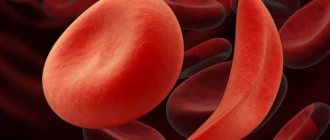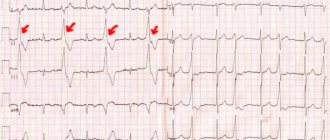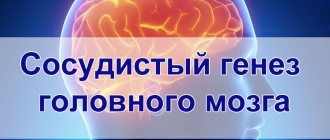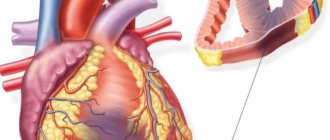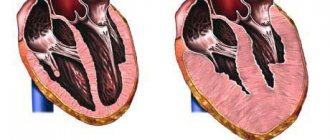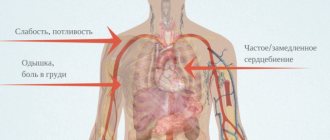In diseases of the cardiovascular system, both the heart and blood vessels, as well as organs of other systems, are affected, and the kidneys are no exception.
Due to disruption of the cardiovascular system, kidney infarction sometimes occurs. This condition is not a separate disease, but is considered a complication of other ailments.
The disease can occur both in people with cardiovascular diseases and in people with obesity and metabolic disorders.
Definition
Kidney infarction is a rare urological disease that is accompanied by the death of organ cells as a result of cessation of blood circulation in the renal artery or its branches.
Most often, this pathology occurs in mature and elderly people. Pathophysiologists attribute this to the fact that concomitant diseases that appear in a person with age create favorable conditions for the development of a heart attack. If the vessels are almost clogged on both sides, then the patient will face death. It can occur both from acute intoxication with metabolic products, and from poisoning by toxins that enter the blood from a dead organ. The risk of death is also present with unilateral lesions if the patient has concomitant kidney diseases.
Pathogenesis
The fundamental link in the pathogenesis in more than 90% of cases of renal infarction is considered to be the formation of emboli, which cause blockage of the organ’s vessels. As a result, the supply of oxygen and nutrients to the area of the kidney tissue is disrupted. In terms of oxygen demand, the kidneys are second only to nervous tissue and myocardium, which is why, as a result of ischemia, dystrophic changes quite quickly occur in nephron cells. The size of the lesion depends on the caliber of the arterial vessel blocked by the embolus - the larger it is, the more widespread the infarction zone. The characteristic shape of the ischemic zone is wedge-shaped or triangular with the apex at the renal hilum and the base facing the cortex. This is due to the peculiarities of the distribution of blood vessels in the organ.
After the cessation of arterial blood supply, the degeneration of nephron cells gradually increases, giving way to their death and the formation of areas of necrosis. At the same time, irritation of the juxtaglomerular apparatus occurs with the formation of large quantities of the hormone angiotensin 2, which leads to the development of vasorenal hypertension and a cascade of associated disorders (increases the risk of myocardial infarction or stroke). The breakdown products of necrotic tissue are absorbed into the systemic bloodstream and cause intoxication of the body, manifested by fever, headaches, and nausea. The outcome of necrosis is the proliferation of fibrous tissue and the formation of a scar.
General characteristics and types of pathology
Kidney infarction is the death of organ tissue associated with a violation of its blood supply. If a blood clot forms in a vessel, there is an obstruction to normal blood flow. Because of this, a separate area of the organ lacks oxygen, so the cells located there die.
In most cases, this pathology occurs in older people, especially if they suffer from obesity and metabolic disorders in the body.
Kidney infarction develops as follows:
- in the cortical substance of the organ, a section of tissue that has a triangular shape dies;
- nephron cells die;
- there is a decrease in the size of the organ;
- kidney tissue atrophies;
- the medulla of the organ atrophies and gradually becomes overgrown with connective tissue.
There are the following types of pathology:
- Hemorrhagic, or red, kidney infarction. This type of violation occurs due to pathologies of the veins, in case of their blockage. As a result, the possibility of outflow of venous blood is blocked. For this reason, cells located above the site of the disorder die, and venous blood accumulates. The infarcted area turns red. Hemorrhagic renal infarction is rare in medical practice.
- Ischemic (anemic, white) infarction. Pathology develops when the artery is blocked. The area of the organ that does not receive blood becomes lighter and becomes white. The consistency of the organ in this area is dense.
- The uric acid form of renal infarction is separately noted. The disorder is caused by the accumulation of uric acid. This form of the disease is most often observed in newborns and is considered harmless to them. This type of heart attack is much more difficult for adults to suffer.
Depending on the degree of organ damage, a heart attack can be:
- total or subtotal, in which a large area of renal tissue is damaged, involving different layers;
- limited, which extends to the cortex; in this case, the pathological process does not affect the medulla.
Description of drugs in Lesson No. 01.02
Description of drugs in Pathological Anatomy in Lesson No. 1,2
(This is an indicative description, not a departmental one, some drugs may be missing, since the description of previous years)
LESSON No. 1 HISTORY OF THE DEPARTMENT OF PATH. ANATOMY OF MMA NAMED AFTER I.M. SECHENOV LESSON No. 2 NECROSIS.
APOPTOSIS. Electronogram No. 20 ISCHEMIC INFARCTION OF THE SPLEN
There is swelling of mitochondria with destruction of the crypts, with the appearance of calcium deposits on them. Destruction of lysosomes.
Microslide No. 7 NECROSIS OF THE EPITHELIUM OF THE CONVOLVED PROXIMAL AND DISTAL TUBULES OF THE KIDNEY. HEMATOXYLIN-EOSIN STAINING
Distal prox tubules are unchanged. The epithelium and glomeruli contain nuclei. The cytoplasm is coagulated and homogeneous in some places. Destruction of the basement membrane (tubulorrhexis) is observed. Karyopyknosis, karyolysis, and plasmorrhexis are noted. The capillaries of the glomerular loop are anemic, and the vessels of the medulla of the kidney are full-blooded
Microslide No. 6 ISCHEMIC RENAL INFARCTION. HEM COLORS. – EOD
.
The necrosis zone is represented by structureless masses, surrounded by a zone of demarcation inflammation, represented by full-blooded vessels with dilated lumens and polymorphonuclear leukocytes. In the focus of necrosis, the tissue structure is disturbed, the nucleus is not stained, with signs of karyopyknosis, karyorrhexis, and karyolysis.
Microslide No. 8 NECROSIS OF LYMPH FOLLICULS. NODES (SURROUNDING GEM.-EOZ.)
A homogeneous structureless mass is determined in the center of the follicle. Along the periphery there are single lymphocytes of small sizes (as part of karyopyknosis). There are many randomly located clumps of formatin (karyorrhexis)
Microslide PANCREONECROSIS (OCR. HEM.-EOS.)
The glandular tissue is represented by a structureless mass, containing single nuclei in the composition of karyopyknosis. Contains chromatin clumps
Microslide No. 215 ISCHEMIA ZONE IN THE MYOCARDIUM. CHIC REACTION.
Presence of glycogen – cardiomyocytes – crimson areas. Lack of glycogen - light areas.
Macro specimen ISCHEMIC INFARCTION OF THE SPLEN
The shape and dimensions have not been changed. The color is heterogeneous - in general it is brown-red, but from the gate to the periphery of the organ there is a 1-2 cm strip of paler color. The focus of necrosis is triangular in shape, dense in consistency, the base faces the capsule. On the capsule in the area of the infarction there are rough deposits of fibrin. D-z: Acute ischemic infarction of the spleen
Macroscopic specimen of BRAIN INFARCTION. FOCUS OF GRAY SOFTENING.
The lesion is located in the occipital region of the left hemisphere, grayish in color, irregular in shape, flabby consistency. Occurred due to a blood clot or embolism of cerebral vessels.
Macro specimen of GANGRENE TOE
Dry gangrene. The fabrics are black (due to iron sulfide deposits). Reduced in volume, with a well-defined zone of demarcation inflammation.
Macro-drug of GUNS GANGRENE
Gangrene is wet. The intestinal wall is thickened, edematous, flabby consistency, black-red in color. The serous membrane is dull with fibrin deposits. Thrombosis of the superior mesenteric artery.
Macrodrug TUBERCULOSIS LYMPH. KNOTS
In the lymph area there is a zone of caseous (cheesy) necrosis. Yellowish-gray color, dense consistency, crumbling.
Macropreparation PETRIFICATIONS IN THE LUNG (for tuberculosis)
Round shape, whitish-gray color, rocky density (due to calcium deposition)
Kidney infarction in children
Ischemic or hemorrhagic infarction in children can occur only in the case of congenital cardiovascular defects, that is, in those with a predisposing disease. A special place is occupied by uric acid infarction of the kidney. This is a pathology that occurs in newborns.
Uric acid infarction is an adaptation syndrome that manifests itself in children as a reaction to new environmental conditions. The blood buffer systems of newborns are not yet stable, the amount of fluid excreted by the kidneys is insufficient, and uric acid salts may be retained in the kidney tissues.
Uric acid infarction can occur in the first days after the baby is born, and as the kidneys adapt to new conditions, they begin to work independently. The symptoms of a heart attack should disappear on their own. If a uric acid infarction in a child does not go away 10 days after birth, then the condition can be considered a pathology.
Symptoms of a sore kidney are also possible in children. They usually occur in babies with congenital heart defects or when the valve apparatus is damaged due to rheumatism. In addition, they have a condition called uric acid kidney infarction.
Uric acid infarction occurs exclusively in newborns, so it is largely the concern of neonatologists. After birth, the child must adapt to existence outside the mother’s body, which does not always go unnoticed for him. Since the blood buffer systems are not yet perfect, and the urine portions are too small, uric acid salts may precipitate in the renal parenchyma.
As you grow older, the consequences of these heart attacks disappear and they no longer pose any danger. A heart attack that lasts longer than the tenth day of a child’s life can be considered pathological.
Symptoms
Since this disease manifests itself and progresses in the first days of a baby’s life, when he and his mother are in the hospital, determining its presence is not difficult. The main symptoms include:
- Change in urine color. It takes on a dark red hue.
- Brick-colored stains left by urine may form on a diaper or diaper. Also sometimes small crystals appear, very similar to salt crystals. They have a similar color - brick.
- Despite all these changes, the newborn’s well-being does not deteriorate.
- The symptoms do not progress and disappear within a week.
There should be no other symptoms. If a child exhibits symptoms such as fever or vomiting, this indicates the development or already manifestation of another disease. It is necessary to monitor the child’s condition (see point 4 of the list above). The fact is that the outpatient period may be prolonged. Do not think that in this case there is no likelihood of complications. In this case, it is recommended to consult a specialized pediatrician for advice.
Symptoms of kidney infarction
The symptoms of renal infarction directly depend on the size of the area of renal tissue where necrosis is localized. If the lesion is small, then symptoms may not appear at all. In the presence of large foci of infarction, pain appears, localized mainly in the lumbar region. Blood appears in the urine (hematuria). Later, a decrease in diuresis may be observed, which indicates a decrease in the excretory capacity of the kidneys.
Kidney infarction
On the second day the symptoms intensify. Patients' temperature rises to 37.5 degrees, hypertension occurs due to ischemia of tissues located near necrosis. Symptoms of general intoxication of the body also appear - nausea, headache, vomiting.
With the development of uric acid infarction, the newborn’s urine becomes cloudy (due to urates). Its color changes to brown. Reddish-brown stains may be noted on the diapers. There are no symptoms of general intoxication of the body. If you conduct a general urine test (UCA), it will contain an increased urate content.
The severity of the pathology depends on the degree of damage, as well as the nature of the necrotic process. If a small area of an organ is affected, the pathology does not manifest itself in any symptoms.
The following signs are characteristic of a renal infarction:
- pain in the lumbar region, radiating to the perineum and groin;
- chills;
- cardiopalmus;
- increased blood pressure;
- decrease in the amount of urine excreted;
- nausea and vomiting;
- flatulence;
- anxiety;
- loss of appetite;
- increased body temperature (usually no more than 38 degrees);
- the appearance of traces of blood in the urine, blood clots can be quite large and complicate the process of emptying the bladder;
- stomach ache.
In newborns, renal infarction of the uric acid type is expressed in the following symptoms:
- red-brown (brick) color of urine, the appearance of sediment in it;
- dark spots on diapers left after urine, on which salt crystals are clearly visible;
- discoloration of the area near the urethra, which turns brown.
In newborns, manifestations of renal infarction are observed on the second to fifth day after birth. In most cases, such symptoms disappear on their own within a few days: a heart attack in this case is an indication that the newborn is adapting to new conditions, and his kidneys are beginning to independently filter and excrete urine. If the symptoms of a kidney infarction in an infant do not disappear within 10 days, you should urgently consult a doctor.
About the disease
Not everyone knows what a kidney infarction is and why it happens. This pathology occurs due to embolism of the arterial vessels of the kidney, leading to tissue necrosis and dysfunction of the organ.
Symptoms of the disease depend on the degree of tissue damage. One patient may have no symptoms at all, while another develops severe pain in the lumbar region, increases blood pressure, develops hematuria and renal failure.
The diagnosis is made based on complaints, test results, ultrasound and renal angiography.
Depending on the severity of the disease, treatment may be medical or surgical.
Causes of the disease
Oddly enough, but an adult can also be diagnosed with uric acid kidney infarction. The causes of this condition are associated with diseases such as gout or cancer.
Blockage of kidney vessels occurs due to the circulation of emboli in the circulatory system. They appear in cardiac pathologies: atrial fibrillation, mitral defects, atherosclerosis, periarteritis nodosa, myocardial infarction, aortic thrombosis and infective endocarditis.
Kidney infarction can also occur in people who have undergone surgery on the renal arteries. In obstetrics and traumatology, such pathology as disseminated intravascular coagulation syndrome is also considered. In simple terms, this is the appearance of multiple small blood clots against the background of hypocoagulation. Patients in this case are characterized by necrosis, in which the affected area is the cortical layer.
Based on the mechanism of development of necrosis, the following forms of renal infarction are distinguished:
- Hemorrhagic – occurs with venous pathologies. The veins become blocked, blocking the flow of venous blood. Cell necrosis occurs above the lesion; accumulated blood causes the infarction area to turn red.
- Ischemic – develops when an arterial vessel is blocked. It is much more common than hemorrhagic infarction. There is a cessation of blood flow to the kidneys, which causes ischemia. The cells die and the infarction area becomes white (bledless).
Based on the localization of the necrosis focus, renal infarction is divided into:
- limited to the cortex of the organ;
- spread to the medulla in the form of a cone directed towards the periphery of the kidney;
- total and subtotal – the entire organ is damaged.
On a note! With a kidney infarction, changes are observed in the form of necrosis of cell components, edema, hemorrhage, and destruction of tissue fibers. The kidney tubules are the first to be damaged, since they bear the greatest functional load.
Causes
Due to the fact that renal infarction occurs against the background of blockage of the renal vessels, the cause of such a dangerous pathology should be considered precisely in this.
It should be noted that the kidney vessels are quite large, so blockage cannot just happen.
Urologists point out that in most cases, infarction of the renal organs is provoked by certain concomitant pathologies.
In particular, such a urological pathology can be provoked by a heart attack, and with it other dangerous cardiac pathologies.
A defect in the main human motor, the heart, quite often leads to damage to its inner layer, followed by blood clots entering the arterial bed.
Following the main aortas, such clots penetrate into the arteries that supply other internal organs, including the kidneys.
Vessels can also be negatively affected by atherosclerosis. It can also provoke necrosis of the parenchyma of the renal organs - atrial fibrillation. As complications, it is followed by thromboembolic syndrome, which provokes the occurrence of blood clots.
An increased occurrence of blood clots is also characteristic of bacterial endocarditis against the background of a serious inflammatory process involving the inner walls of the heart.
Frequent surges in blood pressure, when the patient experiences a constant increase in blood pressure, can also lead to kidney infarction.
Urologists note that atherosclerosis, due to which blood vessels become clogged with atherosclerotic plaques, can also provoke the occurrence of such kidney pathology.
In some cases, such plaques can undergo rapid growth and then rupture, against the background of which such dangerous blood clots arise.
Diagnostic methods
Detection of pathology is based on the following diagnostic methods:
- history taking, general visual examination;
- blood and urine tests;
- cytoscopy;
- ultrasound examination of the kidneys;
- angiography;
- coagulological tests to study the process of blood clot formation;
- MRI;
- CT;
- Dopplerography.
If death of kidney tissue is suspected, differential diagnosis is also carried out to exclude diseases with similar symptoms. In this case, the possibility of aortic aneurysm dissection, hepatic colic, tumors of the genitourinary system, and glomerulonephritis is excluded.
Diagnostics
Kidney infarction is a fairly rare disease with obscure clinical symptoms, so it is quite difficult to identify. In order to make a diagnosis, the doctor collects a detailed medical history. Questions the patient about medications taken, surgeries undergone and other details.
It is important to tell your doctor about the presence of rheumatism, endocarditis or heart defects, as they can also cause thrombosis. General blood and urine tests, as well as blood biochemistry, will help you understand the level of toxins in the body. Increased lactate dehydrogenase is a specific marker of kidney damage. The presence of blood in the urine is a direct indication for cystoscopy. This is necessary to exclude other sources of bleeding, for example, from the urethra or bladder.
Instrumental studies help visualize renal infarction. Ultrasound of the abdominal organs with Doppler sonography allows you to examine the area of necrosis and check the level of blood flow in it. In addition, vascular damage can be seen using angiography. But this is an invasive method that is not suitable for everyone.
Clinic
The symptoms of a sore kidney depend on how many nephrons have died. If necrosis in volume does not exceed a few millimeters, then a person may not even be aware of it. But with large lesions, the appearance of symptoms will not be long in coming.
First of all, pain appears in the lower back. Then the patient's temperature rises to thirty-eight degrees. This is how inflammation manifests itself, which develops in the necrosis zone on the second or third day after the development of ischemia. The patient complains of chills, fatigue, drowsiness, and nausea. Blood clots will be visible to the naked eye in the urine.
Such symptoms predominate in ischemic necrosis, but hemorrhagic ischemia is much more severe. Symptoms may not be noticeable at first, but gradually the temperature rises to 39-40 degrees, accompanied by weakness, anxiety and insomnia. Lying on your back is almost impossible.
In newborns, the general condition does not suffer, but the color of the urine changes from yellow to brick. This always causes panic among parents.
Uric acid infarction: symptoms, treatment in children (newborns) and adults
DlyaSerdca → Heart diseases → Heart attack → Uric acid kidney infarction: is there any cause for concern?
Uric acid renal infarction in children is a physiological condition that is not related to any pathology.
This is the process of adaptation of the body of a newborn child to extrauterine life - the transition to independent breathing and changes in metabolism.
A heart attack is one of the processes called borderline, since it occurs at the junction of intra- and extrauterine life in the first days after birth.
It occurs in approximately 30% of full-term infants in the first seven to ten days of life.
It occurs much less frequently in premature infants - approximately 10%; in very premature infants it practically does not occur.
Uric acid infarction of the kidneys has characteristic signs that immediately attract the attention of the mother or medical staff. These include:
- opaque red-brown urine, upon settling, a clearly visible, rather abundant precipitate of uric acid salts falls out;
- urine leaves colored spots on diapers or diapers, where uric acid can crystallize in the form of a fine salt;
- brown staining around the urethra;
- there is no deterioration in the health of the newborn;
- symptoms occur from the second to the fifth day of life (this is the so-called infarction period) and disappear within two to three days without treatment.
Diagnosis and treatment
Doesn't cause any problems. Based on the characteristic features of urine (without deterioration of the general condition) of children in the first 10 days of life.
Microscopic examination reveals hyaline cylinders in their pure form and with deposits of salt crystals, urate in the form of rods and balls. Microhematuria is often observed.
Despite the name, uric acid renal infarction in infants is not a disease; the epithelium of the renal tubules does not undergo dystrophy, the structure of the renal tissue is not affected or changed, so the child does not need treatment.
The main recommendation is to give plenty of water in addition to regular feeding to increase the formation and flow of urine.
No other action is required. Urine status usually returns to normal within 48 hours. The prognosis is favorable.
But if the urine does not return to normal within a week, the child behaves restlessly, or has a fever, then the child needs to be examined for the presence of kidney diseases.
Unlike children, for adults this condition indicates the presence of serious chronic diseases and is much more severe.
In particular, uric acid infarction is observed in gout, leukemia (especially during treatment, when there is massive death of leukemic elements), during and after treatment of pneumonic crises (caused by the disintegration of exudate and absorption of its components), the disintegration of tumors during chemotherapy, in severe purulent processes.
Note! In these cases, a heart attack is also not an independent disease, but only indicates other catabolic processes occurring in the body.
Better read what Olga Markovich says about this. For several years I suffered from atherosclerosis, ischemic heart disease, tachycardia and angina pectoris - pain and discomfort in the heart, irregular heart rhythms, high blood pressure, shortness of breath even with the slightest physical exertion.
Endless tests, visits to doctors, and pills did not solve my problems. BUT thanks to a simple recipe, constant pain and tingling in the heart, high blood pressure, shortness of breath - all this is a thing of the past. I feel great!!! Now my attending physician is surprised how this is so.
Here is a link to the article.
Source: https://DlyaSerdca.ru/zabolevaniya/infarkt/mochekislyj-infarkt-u-vzroslyx-iu-novorozhdennyx.html
Approaches to the treatment of renal infarction
In most cases, pathology therapy is carried out based on conservative methods, but in some cases surgical intervention may be prescribed.
Patients with renal infarction are prescribed the following medications:
- Painkillers. With necrosis of the kidneys, severe pain can occur, which can only be relieved with the help of potent drugs. In this case, Fentanyl, Omnopon or Morphine are used.
- Thrombolytic. The main task of such drugs is to dissolve the blood clot that clogs the vessel. As a result, normal blood flow is restored. Thrombolytics can be used only in the initial stages of the pathological process, until severe hematuria develops. Such drugs include Streptokinase.
- Hemostatic. They are prescribed if there are traces of blood in the urine. Typically, sodium ethamsylate is used under such conditions.
- Anticoagulants. Medicines normalize blood clotting function. These include Clexane, Heparin.
- Antiplatelet agents. Medicines in this group reduce the risk of relapse and complications. Acetylsalicylic acid, Aspirin, and Ticlopidine are usually prescribed.
Also, in case of kidney infarction, intravenous infusions are indicated, which help prevent blood thickening and combat hypotension and acidosis.
Surgery is required in severe cases. Thus, the indication for surgery is total renal infarction. This method is also used if there is no effect from drugs that help dissolve the blood clot in the vessel.
For necrosis of kidney tissue, the following types of surgical interventions can be performed:
- thrombectomy - removal of a blood clot or embolus to restore normal patency of blood vessels;
- balloon angioplasty, the essence of which is to insert a catheter with a balloon at the end, which is directed into the pathologically altered artery and inflates it, thereby destroying the blood clot;
- nephrectomy (complete removal of the kidney): this radical method is required if necrosis covers the entire kidney, as well as with persistent hypertension and hematuria, which could not be managed using conservative methods.
Patient's diet
If you have a kidney infarction, your diet should be adjusted. Necessary:
- limit salt intake as much as possible (daily dose should not exceed 2-2.5 g);
- maintain a drinking regime: the daily fluid intake for kidney pathology is 1-1.2 l;
- avoid fried and fatty foods;
- replace difficult-to-digest protein with easily digestible protein; the best sources of protein for kidney necrosis are rabbit meat, chicken, turkey, and lean fish;
- include in the menu as many fresh and stewed vegetables as possible, and low-fat dairy products.
Patients are prohibited from eating pickles, smoked meats, marinades, spicy and hot dishes, onions and garlic, mushrooms, sorrel, asparagus, and chocolate. You can't drink coffee or cocoa.
People with kidney necrosis can include in their diet baked goods without salt (preferably homemade), juices and compotes from fresh fruits, any types of cereals, soups and borscht with water, vegetable and unsalted butter, dried fruits, honey.
Folk remedies
Folk remedies for renal infarction are symptomatic. They can be included in the complex of therapy only as prescribed by a doctor.
For pathology, you can use the following methods of traditional therapy:
- Oat decoction. You need to take 200 g of oats and add a liter of water, put on fire, bring to a boil. After this, turn off the stove and strain the broth. Take the finished product chilled, half a glass, 3-4 times a day.
- Freshly squeezed carrot juice. Place several large root vegetables in a juicer. Take the resulting juice half a glass several times a day, adding 5 g of vegetable oil.
- Infusion of birch buds. You need to take a teaspoon of raw material, pour in 300 ml of boiled water, leave for 2 hours, then strain. Take the product 4 times a day, one tablespoon.
- Motherwort infusion. To prepare this medicine, you need to take a teaspoon of crushed raw materials and pour a glass of boiling water, let the liquid brew for 30 minutes. The finished product should be drunk three times a day, half a glass.
- A mixture of rowan and honey. You need to take a kilogram of chokeberry berries and pass the raw materials through a meat grinder, add 2 kg of natural honey to the finished mass. Take a tablespoon of the product per day.
- Composition based on sprouted wheat. You need to take 100 g of young wheat grains and fill them with water so that they are covered with it. The wheat should begin to sprout. When the sprouts reach 1 mm, you need to remove them from the liquid, rinse and chop. Add a tablespoon of vegetable oil and natural honey to the mixture, as well as a few prunes and raisins minced through a meat grinder. Take the prepared product in the morning, one tablespoon at a time.
- To stabilize the patient’s condition, it is recommended to consume a teaspoon of seaweed powder per day and eat boiled unsalted potatoes, which should be washed down with yogurt.
Traditional methods can complement, but not replace, the main course of treatment.
Treatment options
The drug treatment regimen for the disease includes:
- Analgesics. To eliminate intense pain, narcotic analgesics based on morphine are used.
- Thrombolytics (Streptokinase). The drugs dissolve blood clots, restoring vascular patency. The drugs are used in the first stage of a heart attack. Once blood appears in the urine, substances cannot be administered.
- Hemostatics (Ditsinon). Used for severe renal bleeding.
- Anticoagulants (Heparin). Eliminate pathological blood clotting. Doses are selected individually.
- Antiplatelet agents (Aspirin). Not used in the acute period of a heart attack. They begin to be administered 14 days after the elimination of hematuria.
Important information: What is myocardial inferior wall infarction (posterior basal)
Extensive renal infarction is treated surgically. The operation is aimed at restoring renal blood flow. If the disease is detected late, the kidney is removed. Ancillary therapeutic methods include hemodialysis, aimed at removing toxins from the body.
Complications
It is not the kidney infarction itself that is scary. The symptoms, of course, are not pleasant, but at the same time, with good treatment, all lost functions can be restored. It is more dangerous when the pathology was not diagnosed in time or the volume of the lesion is so large that the remaining working tissue cannot cope with the amount of toxins.
After a heart attack, the damaged area is sclerosed and replaced by connective tissue. This leads to decreased kidney function and, as a result, acute or chronic renal failure. Such people are forced to go to dialysis sessions three times a week, and their lives are constantly tied to a medical institution where the necessary equipment is available.
Is it possible to fly on an airplane if you have hypertension?
In the twenty-first century, many people are forced to resort to air transport. It is faster, more modern and more convenient. Flying on an airplane is not inherent in human nature, so it often causes stress reactions
Pregnant women and women with small children should be careful when traveling on an airplane.
People suffering from pathologies of the digestive system complain of severe nausea and vomiting. As for cardiovascular diseases, a stressful flight with hypertension is one of the risk factors. The higher a person rises above sea level, the more barometric pressure, air composition and microclimate change.
Why are air travel dangerous?
With hypertension, leaving the comfort zone leads to the production of the stress hormone - adrenaline, which provokes a rapid heartbeat, increased blood pressure, and accelerated metabolism.
Forecast
Kidney infarction is a pathology that has a predominantly favorable prognosis. With timely treatment, the tissues surrounding the area of necrosis are fully functional and perform the functions of the affected area.
The most dangerous and common consequence of the pathology is nephrosclerosis - a condition in which connective tissue begins to form instead of dead tissue.
If the pathological process was widespread and a large part of the organ was lost, there is a high risk of developing arterial hypertension due to chronic renal failure.
Patients who have suffered a kidney infarction and surgical treatment are usually prescribed a long or even lifelong course of medications that reduce blood clots.
Kidney infarction is a fairly rare and serious disease, but the prognosis is usually favorable. The area of necrosis is eventually replaced by connective tissue, and the remainder of the organ is enlarged to compensate for the loss in volume and function. The amount of urine does not change, especially if the paired kidney is healthy.
Because these patients remain at risk of thrombosis and embolism, they are prescribed anticoagulants for years, and sometimes for the rest of their lives. The outcomes of renal infarction depend on the area affected and the speed of medical care.
Etiology
Kidney infarction progresses due to blockage of the renal artery by emboli. As a rule, blood clots can be transferred to this vessel from the left ventricle or atrium. Therefore, many clinicians consider this disease to be a complication of pathologies of the cardiovascular system:
- myocardial infarction;
- atrial fibrillation;
- periarteritis nodosa;
- infective endocarditis;
- vascular atherosclerosis.
Kidney infarction sometimes begins to progress if the patient has previously undergone surgery on the renal vessels.
Uric acid renal infarction in a newborn develops as a result of birth stress. This pathology can also begin to develop in adults. It usually develops against the background of:
- leukemia;
- purulent process;
- tumors of a benign or malignant nature.
Kidney infarction: causes, symptoms, treatment, prevention
Kidney infarction is a complication of the pathology of the cardiovascular system, therefore preventive measures consist of timely treatment of the primary disease. You must strictly follow all the cardiologist’s instructions, monitor your blood pressure and visit your doctor regularly. The appearance of massive vegetations, thickening of veins in the legs or abdomen is an alarming sign; you should immediately consult a specialist.
The main prevention of this disease is timely diagnosis and treatment of diseases of the cardiovascular system. To prevent the development of vascular atherosclerosis, drugs that reduce the level of “bad” cholesterol in the blood, as well as antiplatelet agents, can be prescribed.
It is important to normalize your diet. It is necessary to include more vegetables, fruits, as well as foods that contain many vitamins and minerals. It is best to limit the consumption of fatty meats, smoked meats, and spicy foods.
Kidney infarction can be prevented by preventing cardiovascular diseases that provoke it. To prevent atherosclerosis, you need to take drugs to lower cholesterol levels (fibrates, statins).
In the presence of vascular atherosclerosis, antiplatelet agents are indicated:
- Clopidogrel;
- Tiklid and others.
You need to adhere to proper nutrition, which includes limiting fatty, smoked, and spicy foods. In your diet, increase the amount of fresh fruits, vegetables, and foods rich in vitamins.
Kidney infarction is diagnosed much less frequently than myocardial infarction. Prerequisites for the development of the disease are pathologies of the heart and blood vessels. It is important to take early action to prevent the disease and monitor the condition of the cardiovascular system.
Prevention of renal infarction consists of timely and appropriate treatment of the disease. To prevent the development of atherosclerosis, medications are taken that lower total cholesterol levels and reduce platelet aggregation (sticking together) of platelets. If there is a degenerative change in blood vessels, they also take medications that reduce thrombus formation by inhibiting platelet aggregation (antiplatelet agents) - aspirin, ticlopidine, clopidogrel.
If there is a high probability of developing thrombosis that poses a threat to the patient’s life (coronary stenting, pacemaker), it is recommended to take ticlopidine (ticlid) and clopidogrel (Plavika).
The action of the drugs is aimed at preventing thrombotic and thromboembolic complications. They are also prescribed if there are contraindications against taking aspirin (aspirin-induced bronchial asthma, exacerbation of stomach ulcers).
Preventive measures include the following:
- Timely treatment of pathologies of the cardiovascular system.
- Proper and balanced nutrition. This is necessary in order to prevent an increase in blood cholesterol levels. It is this substance that causes the formation of atherosclerotic plaques in the vessels, which clog the lumen and disrupt normal blood flow.
- Taking anticoagulants. These medications are necessary if the patient already has atherosclerotic damage to the blood vessels.
- Taking antiplatelet agents for arrhythmias or the presence of artificial valves.
- Quitting smoking and drinking alcoholic beverages.
- Monitoring blood pressure indicators.
Kidney infarction is the result of a violation of blood flow in the organ, due to which individual cells die and foci of necrosis form. The pathology usually has a favorable prognosis, but it is important to begin the treatment process in a timely manner to avoid the development of nephrosclerosis.
Kidney infarction is a rather rare disease characterized by tissue death (necrosis). This happens because blood flow to this vital organ suddenly, unexpectedly and completely stops.
Complications of kidney infarction:
- Acute renal failure;
- Presence of blood in the urine;
- Lack of urine.
This disease can be fatal. But this occurs when the arteries of both kidneys are completely blocked. But this happens quite rarely.
The symptoms of a kidney infarction are quite specific. One of the most characteristic signs is a change in the color of the urine or the presence of blood in it. At the same time, there is a slight increase in temperature to 37.5 degrees.
Sometimes pain appears in the lumbar region. But this symptom occurs only if necrosis has covered fairly large areas of kidney tissue.
If a kidney infarction is suspected, urine and blood tests are first taken. The urologist conducts a thorough interview with the patient, listens to his complaints and collects anamnesis. After this, ultrasound with Dopplerography or angiography is used.
The most effective method for diagnosing renal infarction is magnetic resonance imaging using contrast agents.
Treatment methods
If the diagnosis of renal infarction is confirmed, urgent hospitalization is required. The patient is prescribed strict bed rest and a course of special therapy.
A urologist, when prescribing a particular drug, acts in two directions:
- Reducing the manifestation of pain and discomfort;
- Reduced blood clotting.
Treatment
What is recommended to do after a kidney infarction is diagnosed? Treatment can only be carried out in a hospital, under the supervision of doctors, since the patient must observe strict bed rest. The main doctor in this case will be a urologist, but if necessary, a surgeon or therapist can be involved.
Conservative therapy involves restoring blood flow by dilating blood vessels or by dissolving the embolus (if possible). Thrombolytics and anticoagulants of direct and indirect action are prescribed. It is better to do this as early as possible, before the parenchyma of the organ has time to completely die. In addition, the pain syndrome is definitely relieved. For this, the patient is given narcotic analgesics. If gross hematuria is massive, then hemostatic drugs are prescribed, for example, Etamzilat. To combat dehydration and restore blood volume, the patient is given intravenous fluid infusions.
Surgical treatment is indicated only in the case of a large area of necrosis. If the organ cannot be saved, it is removed completely, disconnected from the vascular pedicle. In other cases, balloon angioplasty or blood clot extraction can be done.
In infants, uric acid infarction goes away on its own and no specific therapy is required. In order for the uric acid crystals to come out faster, you can give your child additional water.
Uric acid infarction of the newborn
Uric acid infarction of a newborn
is a transient state of increased formation and excretion of uric acid salts in the urine, due to the body’s adaptation to extrauterine living conditions. Characteristic changes in the properties of urine, which becomes cloudy, with a reddish-brick tint due to the high concentration of salts. The diagnosis of neonatal uric acid infarction is made based on the typical age of the child and the absence of additional signs. No treatment required. An increased drinking regimen is possible, but medical correction of the condition is not carried out; the composition of urine normalizes on its own within a few days.
